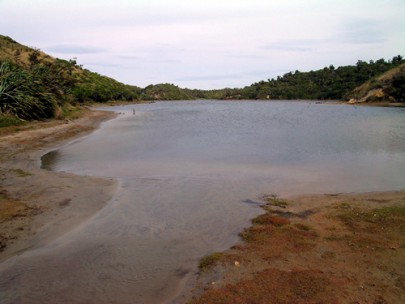Lake margins
In this section

Lake margins at Kaihoka Lakes, Westland (Janet Wilmshurst)
Lakes have been arbitrarily defined as bodies of fresh water having a major dimension of 0.5 km or more (Irwin 1975), but many smaller bodies of water including sand dune lakes, kettle lakes, and oxbow lakes can also be referred to as lakes based on their other physical characteristics. How far landward the margin might be considered to extend is also rather arbitrary, and is used only loosely here. Consequently, lake margin vegetation ranges from periodically inundated podocarp forest as in Westland, through tall reedland and rushland, to sedgeland and herbfield, and down to open land with only scattered herbs on rocky lake shores as in many eastern South Island lakes.
Notable flora and fauna
Threatened plants include the nationally critical marsh arrow grass (Triglochin palustris), Trithuria inconspicua, Stalked adder’s tongue fern (Ophioglossum petiolatum), sneezeweed (Centipeda minima subsp. minima), New Zealand fish-guts plant (Chenopodium detestans), Crassula peduncularis, Deyeuxia lacustris, hairy willowherb (Epilobium hirtigerum), kettlehole cudweed (Pseudognaphalium ephemerum), the nationally endangered Isolepis basilaris, water brome (Amphibromus fluitans), Gunnera densiflora, whipcord hebe (Hebe salicornioides), papataniwha (Lagenifera montana), Lobelia carens, Trithuria inconspicua subsp. brevistyla, hook sedge (Uncinia strictissima) and yellow bladderwort (Utricularia australis). The nationally vulnerable Carmichaelia juncea, Iphigenia novae-zelandiae, curly sedge (Carex cirrhosa), Carex rubicunda, Gratiola concinna, New Zealand water cress (Rorippa divaricata), Lady's tresses (Spiranthes novae-zelandiae) and Isolepis fluitans var. fluitans. Declining species include the stout water milfoil (Myriophyllum robustum), mud buttercup (Ranunculus limosella), and floating schoenus (Schoenus fluitans). Naturally uncommon species include the Enyss sedge (Carex enysii), Lepilaena bilocularis and fennel-leaved pondweed (Potamogeton pectinatus).
Indeterminate species include the nationally critical Isoetes aff. kirkii (CHR 247118A; Lake Omapere).
Some Canterbury tarns contain rare cladocerans (Neothrix armata, Monospilus dispar, and Ephemeroporus barroisi).
Lake margin vegetation forms important breeding areas for several rare birds including the Australasian crested grebe (Podiceps cristatus australis) and the New Zealand dabchick (Poliocephalus rufopectus).
Threat status
Vulnerable (Holdaway et al. 2012)
Threats
Several exotic aquatic weeds such as lagarosiphon (Lagarosiphon major) are a problem. Terrestrial weeds such as Russell lupin (Lupinus polyphyllus) or alligator weed (Alternanthera philoxeroides) and exotic grasses are also a potential threat to some types of lake margins. These areas are mostly located away from urban areas in agricultural landscapes where they are susceptible to grazing, trampling, and nutrient enrichment by domestic and feral animals. Very few are fenced. Some lakes have high recreational value and can be impacted by boating (entry and exit ways), fishing (trampling) and off-road vehicles. The increasing demand for electricity via dams poses a threat to some lakes.
Where do they occur?
Lakes occur throughout New Zealand, from sea level to above treeline, where they are more likely to be called tarns.
Further reading
Bassett I, Paynter Q, Hankin R, Beggs JR 2012. Characterising alligator weed (Alternanthera philoxeroides; Amaranthaceae) invasion at a northern New Zealand lake. New Zealand Journal of Ecology 36: 216-222.
Brownsey PJ 1985. Ophioglossum petiolatum at Hokio Beach. Wellington Botanical Society Journal 42: 33-34.
Gardner RO 1984. Vegetation and Flora at the head of Lake Taupo. Auckland Botanical Society Journal 39: 33-39.
Irwin J 1975. Checklist of New Zealand lakes. New Zealand Oceanographic Institute Memoir 74. Wellington, New Zealand Oceanographic Institute. 161 p.
Johnson P, Gerbeaux P 2004. Wetland types in New Zealand. Wellington, Department of Conservation.
Jolly VH 1975. New Zealand lakes. Auckland, Auckland University Press. 388 p.
Monks A, Burrows L 2014. Are threatened plant species specialists, or just more vulnerable to disturbance? Journal of Applied Ecology 51: 1228–1235.
Winterbourn M, Knox G, Burrows C, Marsden I eds 2008. The natural history of Canterbury. Christchurch, Canterbury University Press. 921 p.


